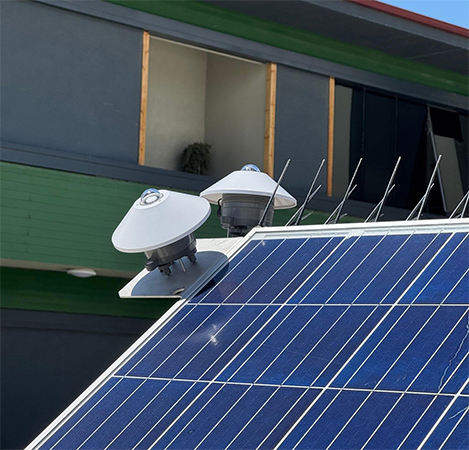In order to accurately analyze the efficiency of solar energy systems, complete and accurate measurement of irradiance data is required. At this point, there are two most common types of measurements: Global Horizontal Irradiance (GHI) and Plane-of-Array Irradiance (POA). You can measure both of these radiation types with the Thermopile Pyranometer. SEVEN Class A 3S-TP-MB-A Thermopile Pyranometer provides high accuracy measurements in both types of radiation with its state-of-the-art technology.
So which of these two metrics is more critical for solar plants? The answer to this question depends on what you want to measure in the system design and performance evaluation process.
What are GHI and POA?
GHI (Global Horizontal Irradiance):
- Total solar radiation incident on the horizontal plane.
- It includes direct (from the sun) + diffuse (scattered from the atmosphere) radiation.
- It is used especially in meteorological assessments and long-term production forecasts.
POA (Plane of Array Irradiance):
- Panel tilt and orientation (azimuth) are taken into account.
- It is the radiation that the solar panel “actually receives”.
- This measurement reflects the actual performance of the panels and is ideal for performance monitoring.
Which Irradiance Type is More Important in SPP Performance Analysis?
- POA is more important. Because;
- POA is used in PR (Performance Ratio) calculation. GHI is not used.
- The energy to be produced by the panel is directly proportional to POA.
- Since POA varies according to the positioning of the system, GHI alone is not enough information.
- For example, two different systems with the same GHI value (one facing south, one facing east) may have different POA values and therefore different production performances.
Why Measure GHI and POA Simultaneously in SPPs?
Sites should use separate pyranometers for both GHI and POA. The reason is to be able to monitor system performance accurately and reliably and to collect data separately for different evaluation purposes.
1. Purpose of GHI Measurement:
- Monitors source potential: The GHI shows the total horizontal radiation incident on your location. It provides a quick reference in the first preliminary analysis for projects spanning large areas. This is important for long-term monitoring of the region’s solar potential.
- Comparison with simulations and forecasts: Typical Meteorological Year (TMY) data used in pre-project PVsyst or similar software is usually GHI based. Measured GHI is compared with these data.
- It provides reference data for acceptance tests and investor audits. Because these data are meteorological data. Meteorological data is GHI data.
- Real-time GHI data can be input to production forecasting algorithms.
2. Purpose of POA Measurement:
- Essential for the evaluation of actual performance.
- The radiation received by the solar panel is the POA. Calculations such as PR (Performance Ratio), efficiency, losses etc. are made directly on POA.
- POA is specific to the orientation and tilt of the panel. Measuring this type of irradiance is much better in terms of accuracy and specific conditions on site.
- Field effects such as soiling, panel tilt, shading directly affect the POA measurement.
GHI vs. POA Pyranometer Comparison Table
| Feature / Purpose | GHI Pyranometer | POA Pyranometer |
| Measured Irradiance Type | Global Horizontal Irradiance (GHI) | Plane of Array Irradiance (POA) |
| Mounting Surface | Horizontal plane | Parallel to panel surface (at module inclination) |
| Affected by Panel Orientation? | No | Yes |
| Use in System Performance Calculations | Indirect | Direct (PR calculation) |
| Simulation and TMY Data Comparison | Yes | No |
| Reflecting Site Conditions | General irradiance | Actual panel conditions (shade, dirt, etc.) |
| Use in Investor/Acceptance Reports | Source data, climatic analysis, etc | Performance analysis and verification |
As a result, GHI measurements are still an essential reference data for both pre-feasibility and continuous performance monitoring of solar energy systems. GHI measurements, especially with reliable and calibrated sensors, provide a solid basis for production analysis by showing general trends in irradiance to the panel surface. POA measurements are preferred for performance monitoring as they measure the actual irradiance incident on the PV panel surface. However, accurate POA measurement requires precision sensors that are precisely aligned with the panel plane.
The 3S-TP-MB-A Thermopile Pyranometer is one of the most accurate sensors for both irradiance types in this field. Its high accuracy, durability and Modbus compatible data output make it a reliable solution for investors and engineers alike. For more information, please visit Seven Sensor Products page .
